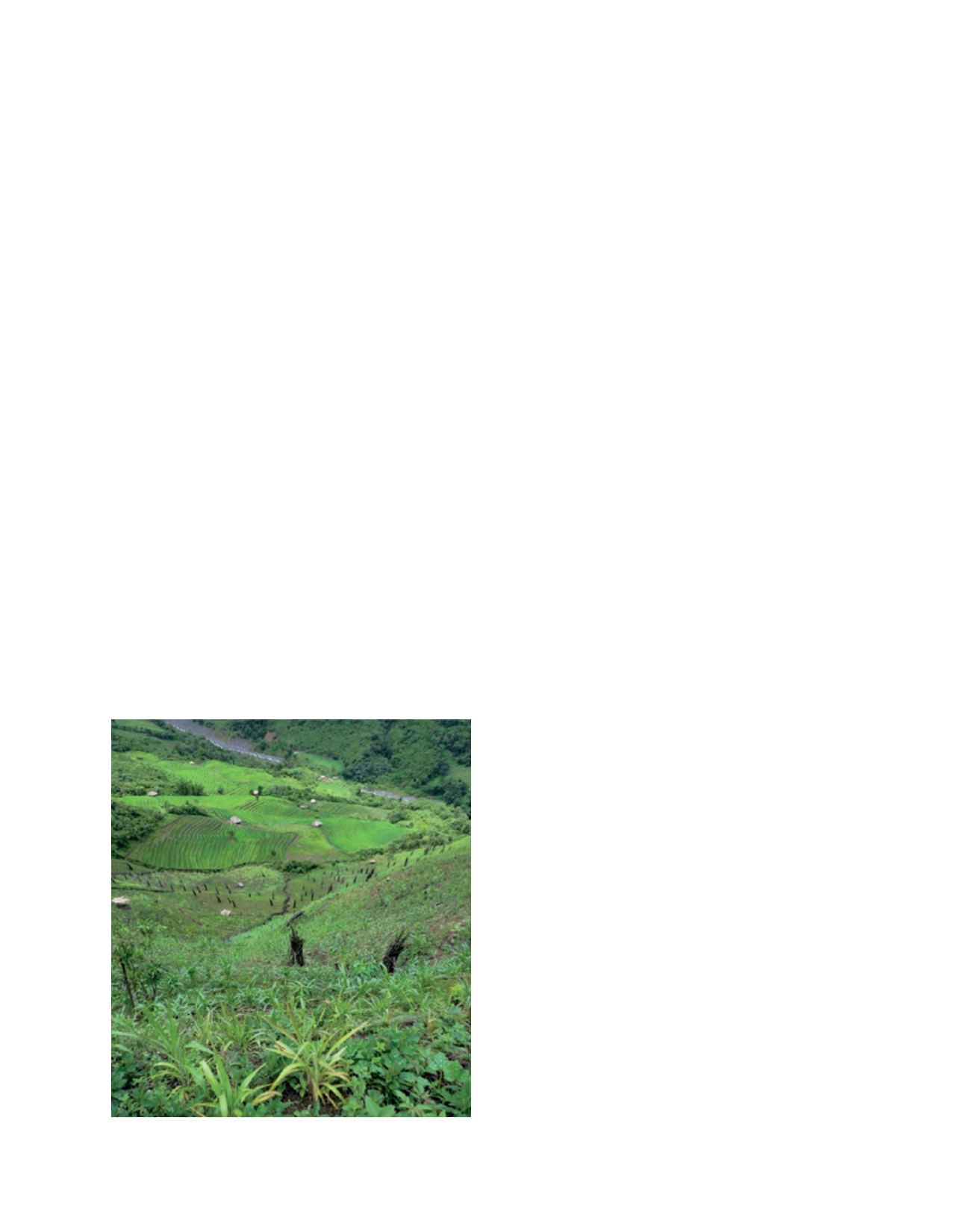

[
] 106
between north-east and north-west Himalayan regions. In the
north-east region shifting cultivation is the most extensive
agriculture land use, which on an average involves the cultiva-
tion of 8-35 crops together including cereals and grains, leafy
vegetables, tubers and rhizomatous crops.
2
Those are harvested
sequentially from July to December; the crop compositions vary
with the site and fallow-length of the jhum fields. Grain- and
seed-yielding crops give high yield after a longer jhum cycle
(60 years), although leafy vegetables, tubers and rhizomatous
crops perform better in areas with shorter jhum cycles (5-10
years).
3
However, in recent decades the jhum cycle has been
shortened to 5-10 years due to growing population and food
demand.
4
Other than jhum cultivation, the region also supports
wet rice cultivation in the valleys. An excellent innovation in
wet rice cultivation is the introduction of fish that maximize
crop output.
5
In the north-east region home gardens are also
maintained to meet diverse household needs.
In the north-west region of IHR agriculture is carried out on
terraces carved out of hill slopes. The cropping patterns, up to
2,000 metres, are built around the two major cropping seasons
of kharif (April-October) and rabi (October-April). As most of
the agriculture is rain-fed and generally three crops are taken
in two years in low hills, and just one crop annually in mid and
high hills. However, in the valley bottom where irrigation is
possible, two or three crops of cereals and vegetables are taken
in one year with limited use of hybrid crop varieties and ferti-
lizers. The average crop yield ranges from 1-2 ton per hectare
per year. To maximize production multi-cropping is a common
practice with as many as 40 crops including cereals, millets,
pseudocereals and pulses cultivated to ensure food secu-
rity.
6
The huge traditional agrodiversity has been maintained
through a variety of crop compositions, cropping patterns and
crop rotation favoured by enormous variations in the edaphic,
topographic and climatic conditions.
7
Cereals, pseudocere-
als and pulses are the main crops of the kharif season while
wheat, barley, mustard, lentils and peas are cultivated in the
rabi season.
In shifting cultivation area, a collective decision is made over
the selection of land for cultivation and the distribution of suit-
able pieces to each family in a village. In the north-west IHR
land belongs to individual family heads, and crop cultivation
and associated practices are solely the choice of the land owner.
However, the entire farming community systematically divides
the entire agricultural land into two halves, each area locally
called as ‘sar’. One sar is brought under cultivation while the
another is left fallow to recover soil fertility status. The system
thus exhibits a remarkable crop rotation trend. In the north-
west region farmyard manure is applied to the agricultural
fields which is derived from composting livestock excreta and
leaf litter. However, this practice is not prevalent in jhum fields
in the north-east. All over the farm families maintain their own
seed banks for various crops although there is also exchange of
such seeds among them. A large variety of agroforestry trees is
maintained in and around the agricultural fields for diverse uses
such as firewood, fodder, fibre, food and for natural fertilizers
to maintain farm fertility.
8
Many commercial crops are grown by farming families in the
IHR – for example, saffron and tulip in Jammu and Kashmir,
and seed-potato, ginger and vegetables in Himachal Pradesh and
Uttarakhand. Also, fruits such as apple, pear, cherry, apricots,
walnuts, mango, litchi and almonds are grown on a large scale
in the north-west region of IHR although the level of produc-
tion varies from state to state. Sikkim state is well known for
cardamom production, whereas the Darjeeling district of West
Bengal and Assam are famed for tea cultivation. In various north-
east states orange, lemon, pineapple, guava, litchi, banana, black
pepper, rubber, areca nut and betel vine are being promoted as
cash crops. Cultivation of medicinal plants has also been intro-
duced in recent years throughout the IHR. It is notable that
niche-specific commercial crops perform much better in the
region. The majority of family farming practices in the IHR are
carried out by smallholders who contribute immensely to the
food security, livelihoods, social protection and well-being of
Himalayan farming communities. Some highlights follow.
Food security and enhanced livelihoods
Family farmers contribute immensely to maintaining agrobio-
diversity (300-500 crop-plant varieties and their wild relatives
with 5,000-10,000 crop cultivars) in the IHR. An individual
farmer grows 20-40 crops and fully understands various agro-
nomic operations and economics to manage them. Thus these
farms can be considered as a source of important genetic mate-
rial. Mixed cropping and the maintenance of genetic diversity are
key features of traditional family farming as diverse production
of mixed crops provides insurance against crop failures. Family
farming contributes significantly to food security as 30-40 per
cent (sometimes more) of the food requirement of small and
marginal farmers is met from their farms. Besides, farmers meet
most of their fodder, fuel and fibre needs from their farms and
surrounding areas. There is continuous use of land with suitable
crop rotation, and high emphasis is placed on the recycling of
crop residues and other resources. Crop residue fed to animals
Mix-cropping in jhum fields, north-east India
Image: G.B. Pant Institute
D
eep
R
oots
















